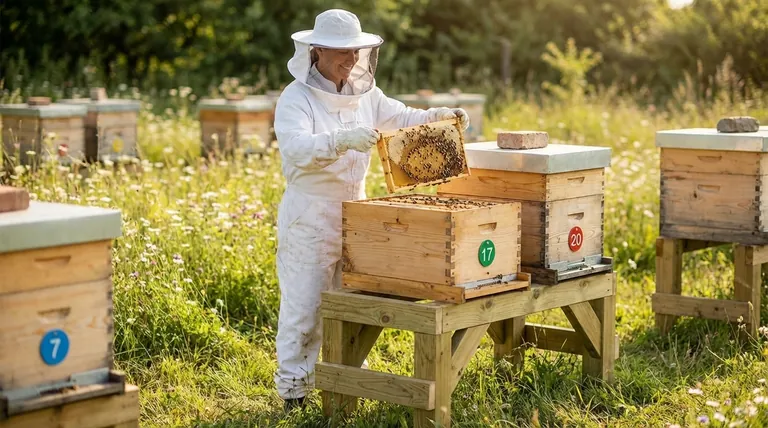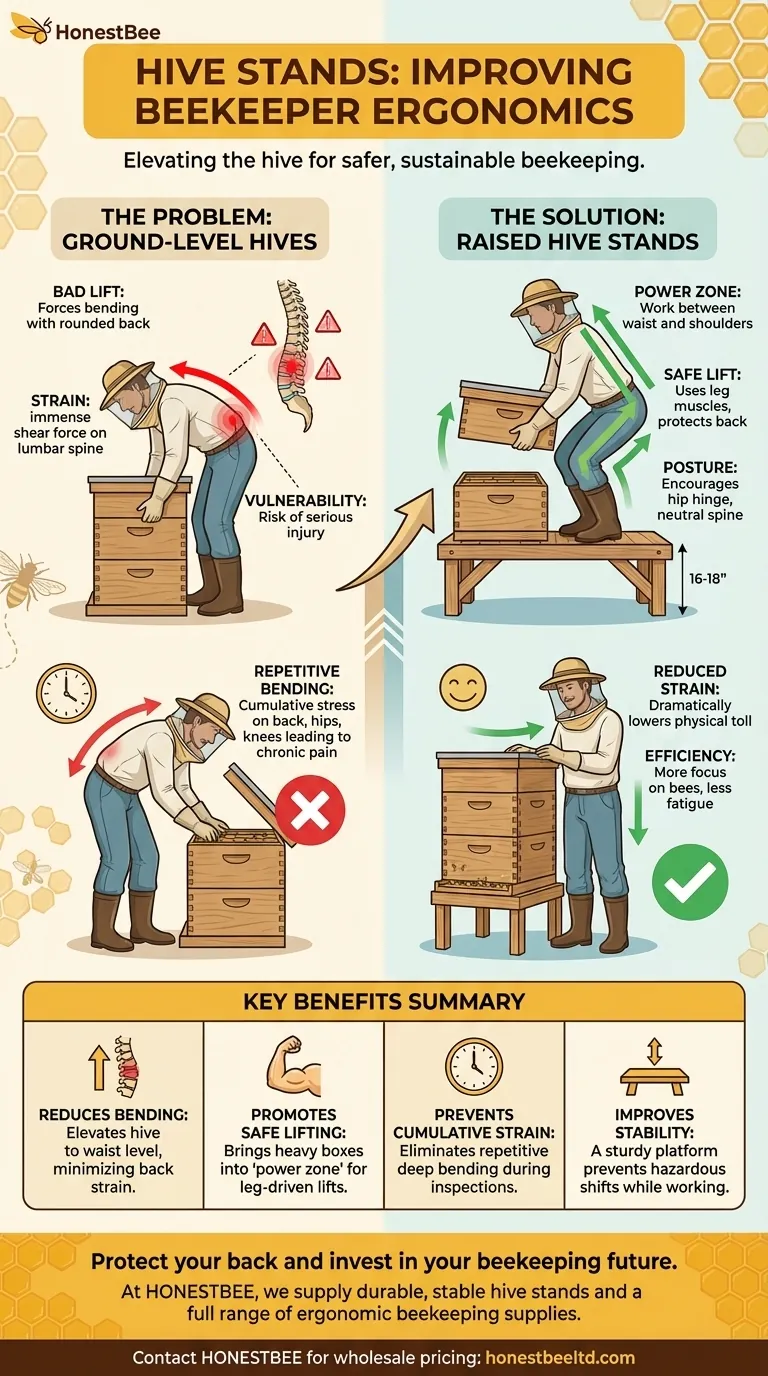In short, a hive stand improves beekeeper ergonomics by raising the hive off the ground. This simple elevation significantly reduces the need to bend deeply at the waist or squat low to the ground when lifting heavy hive boxes or performing routine inspections, directly minimizing strain on the lower back and knees.
The core ergonomic challenge in beekeeping is not just the weight of the equipment, but the awkward postures required to handle that weight. A hive stand is the foundational tool that corrects this by bringing the work into the beekeeper's natural "power zone," transforming a physically taxing activity into a sustainable and comfortable practice.

The Ergonomic Problem with Ground-Level Hives
To understand the solution, we must first define the problem. Placing a beehive directly on the ground creates immediate and cumulative physical challenges that can shorten a beekeeper's career.
The Anatomy of a Bad Lift
A deep super full of honey can weigh 60 to 80 pounds. Lifting this weight from ground level often forces the beekeeper to bend at the waist with a rounded back, placing immense shear force on the lumbar spine.
This posture bypasses the body's strongest muscles—the glutes and legs—and puts the most vulnerable parts of the lower back at risk of strain or serious injury.
The Impact of Repetitive Bending
Even without heavy lifting, the work of beekeeping requires frequent bending. Regular inspections involve leaning over the hive for extended periods to check frames, look for eggs, and monitor colony health.
When the hive is on the ground, this repetitive motion leads to cumulative stress on the back, hips, and knees, causing fatigue and chronic pain over time.
How a Hive Stand Corrects Your Posture
A hive stand is more than just a piece of equipment; it is a tool that fundamentally changes the way your body interacts with the hive, promoting safer and more efficient movement.
Raising the Work to Your "Power Zone"
The most efficient and safest zone for manual work is between your waist and your shoulders. In this "power zone," your arms and back are in their strongest alignment.
A hive stand elevates the hive so that the top boxes—the ones you interact with most—are within this zone. This allows you to work with a more upright, neutral spine.
Encouraging a Hip Hinge, Not a Back Bend
With the hive raised 16 to 18 inches, you no longer need to perform a full, deep squat or a dangerous back bend. Instead, you can use a slight knee bend and a "hip hinge."
This is the body's natural bending movement, engaging the powerful muscles of your legs and hips to do the work while keeping your back straight and protected.
Reducing Cumulative Strain
By eliminating the most extreme bending postures, a hive stand dramatically reduces the overall physical toll of a hive inspection.
The energy you save by not straining your back and knees can be put toward focusing on the bees themselves, making the entire experience less fatiguing and more enjoyable.
Understanding the Trade-offs and Considerations
While a hive stand is overwhelmingly beneficial, choosing and placing one requires some thought to maximize its ergonomic advantages.
The "Right" Height is Personal
There is no single perfect height for a hive stand. The ideal elevation depends entirely on the beekeeper's height.
A good rule of thumb is to aim for a stand height that places the top of your highest hive box at or slightly below your waist. This ensures you aren't reaching too high or bending too low.
Stability is Non-Negotiable
An unstable or wobbly hive stand is an ergonomic hazard. It can shift unexpectedly during a lift, creating a dangerous situation for both you and the bees.
Ensure your stand is on level, compacted ground and is built from sturdy materials that can easily support the 300+ pounds of a full, mature hive. Simple, wide platforms like stacked cinder blocks are often more stable than stands with thin legs.
Making the Right Choice for Your Body
Your goal is to create a working environment that supports your physical well-being for the long term. Use these principles to guide your setup.
- If your primary focus is routine inspections: Choose a stand height that allows you to look down into the top box with only a slight forward lean from your hips, keeping your back straight.
- If your primary focus is reducing lifting strain: Ensure the stand places the handholds of the heaviest boxes well above your knee level, allowing you to perform a safe "power lift" using your legs.
- If your primary focus is long-term sustainability: Experiment with different heights using temporary blocks to find the elevation that feels most natural and comfortable for you before committing to a permanent setup.
Investing in a proper hive stand is a direct investment in your own physical health, ensuring you can continue to enjoy the practice of beekeeping for years to come.
Summary Table:
| Benefit | How It Helps |
|---|---|
| Reduces Bending | Elevates hive to waist level, minimizing strain on the lower back. |
| Promotes Safe Lifting | Brings heavy boxes into your 'power zone' for leg-driven lifts. |
| Prevents Cumulative Strain | Eliminates repetitive deep bending during inspections. |
| Improves Stability | A sturdy platform prevents hazardous shifts while working. |
Protect your back and invest in your beekeeping future. A hive stand is the first step in creating an ergonomic apiary. At HONESTBEE, we supply durable, stable hive stands and a full range of beekeeping supplies designed for the demands of commercial apiaries and equipment distributors. Let us help you build a safer, more efficient operation.
Contact HONESTBEE today for wholesale pricing on ergonomic beekeeping equipment.
Visual Guide

Related Products
- Professional Engraved Round Hive Number Tags for Beekeeping
- Plastic Bee Hive Stand for Beekeeping
- Metal Hive Feet Bee Hive Stand for Ant Protection
- Metal Bee Hive Stand Bee Box Stand for Beekeeping
- Professional Ant-Proof Beehive Stand with Integrated Moat for Beekeeping
People Also Ask
- Do I need a hive stand? Essential for Bee Health & Easier Beekeeping
- Why is it recommended to buy at least two bee hives? Boost Your Success with a Second Colony
- Why are Posca pens commonly used for marking queen bees? The Safest, Most Durable Method for Beekeepers
- What maintenance is required for hive straps? A Guide to Cam Buckle vs. Ratchet Strap Care
- What is the best height for a hive stand? Optimize for Pest Control and Beekeeper Ergonomics



















